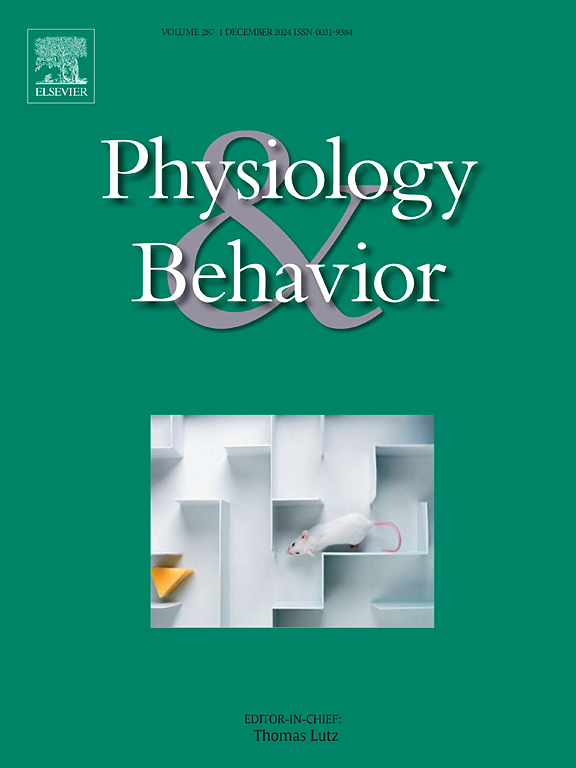Behavioral outcomes in the bystander and demonstrator male mice following a socially-transferred allodynia paradigm
IF 2.5
3区 医学
Q2 BEHAVIORAL SCIENCES
引用次数: 0
Abstract
The state of mechanical allodynia can be socially transferred from one individual to another during a brief empathetic contact. Our recent research has identified inter-individual differences in behavioral adaptations among bystander (BY) mice after a brief social contact with a demonstrator mouse experiencing complete Freund's Adjuvant (CFA)-induced inflammatory pain. However, the impact of the duration of social contact on the development of socially transferred allodynia is not yet clear. Additionally, it remains unknown whether social contact with different subgroups of BY mice differentially affects the pain behavior of CFA demonstrator mice. In the current study, we established a socially transferred allodynia paradigm with varying durations of social contact in male C57BL/6 J mice. We found that a 30-min or a longer social exposure to a CFA demonstrator mouse led to stable mechanical allodynia in naive BY mouse. As the duration of social contact increased, the persistence of the socially transferred allodynia also extended. Interestingly, the CFA demonstrator mice exhibited a partial reversal of mechanical allodynia when exposed to the BY mice for 24 h, but not for shorter durations. Surprisingly, this analgesic-like behavioral adaptation occurred only when the BY mice were susceptible to socially transferred allodynia. These findings demonstrate that behavioral adaptations in both BY and CFA demonstrator mice develop in a time-dependent manner. Additionally, the social contact-induced analgesic-like effect in CFA mice requires a specific cage mate that is susceptible to socially transferred allodynia.
旁观和示范雄性小鼠在社会转移异常性疼痛范式后的行为结果。
机械性异常性痛的状态可以在短暂的共情接触中从一个个体转移到另一个个体。我们最近的研究已经确定了旁观者(BY)小鼠在与经历完全弗氏佐剂(CFA)诱导的炎症性疼痛的示范小鼠进行短暂社会接触后,行为适应的个体间差异。然而,社会接触持续时间对社会转移性异常性疼痛发展的影响尚不清楚。此外,与不同亚群的BY小鼠的社会接触是否会对CFA示范小鼠的疼痛行为产生不同的影响尚不清楚。在本研究中,我们在雄性C57BL/6J小鼠中建立了具有不同社会接触持续时间的社会转移异常性疼痛范式。我们发现,与CFA示范小鼠社会接触30分钟或更长时间会导致初始BY小鼠出现稳定的机械异常性疼痛。随着社会接触持续时间的增加,社会转移性异常性疼痛的持续时间也延长了。有趣的是,CFA证明小鼠在暴露于BY小鼠24小时后表现出机械异常性疼痛的部分逆转,但持续时间不短。令人惊讶的是,这种类似镇痛的行为适应只发生在BY小鼠易受社会转移性异常性疼痛的情况下。这些发现表明,BY和CFA示范小鼠的行为适应都是以时间依赖的方式发展的。此外,在CFA小鼠中,社会接触引起的类似镇痛作用需要一个特定的笼子伴侣,该伴侣容易受到社会转移性异常性疼痛的影响。
本文章由计算机程序翻译,如有差异,请以英文原文为准。
求助全文
约1分钟内获得全文
求助全文
来源期刊

Physiology & Behavior
医学-行为科学
CiteScore
5.70
自引率
3.40%
发文量
274
审稿时长
47 days
期刊介绍:
Physiology & Behavior is aimed at the causal physiological mechanisms of behavior and its modulation by environmental factors. The journal invites original reports in the broad area of behavioral and cognitive neuroscience, in which at least one variable is physiological and the primary emphasis and theoretical context are behavioral. The range of subjects includes behavioral neuroendocrinology, psychoneuroimmunology, learning and memory, ingestion, social behavior, and studies related to the mechanisms of psychopathology. Contemporary reviews and theoretical articles are welcomed and the Editors invite such proposals from interested authors.
 求助内容:
求助内容: 应助结果提醒方式:
应助结果提醒方式:


